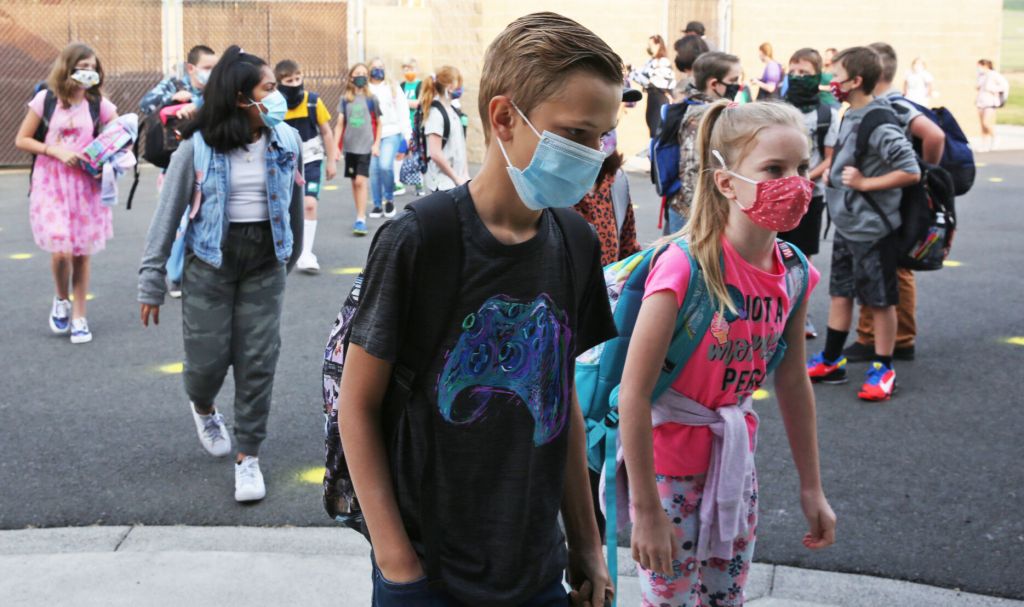Oregon could reach goal to lift mask mandate as early as March 12
Published 11:14 am Thursday, February 24, 2022

- Students wear masks as they file into Sage Elementary School on the first day back to school in Redmond.
Severe cases of COVID-19 are falling so rapidly that Oregon could hit the official target that would allow the end of community indoor-mask mandates as early as March 12.
A new forecast by Oregon Health & Science University released Thursday shows the state dropping below 400 people with COVID-19 in state hospitals by March 12. That’s the mark Gov. Kate Brown had set for ending indoor mask mandates.
Trending
Brown also said on Thursday that she would end the pandemic state of emergency on April 1.
“We can now protect ourselves, our friends and our families without invoking the extraordinary emergency authorities that were necessary at the beginning of the pandemic,” Brown said.
But based on a previous OHSU forecast, the Oregon Health Authority announced Thursday morning that the mask mandate would be lifted March 19. That is the same date Department of Education Director Colt Gill said that masks would also come off at schools.
Gill said school districts had the option of continuing to require masks and individual students could also wear masks after the mandate is lifted.
“Every individual has the right to make that decision and our schools will support the continued use of face coverings by individuals,” Gill said in a statement.
Brown and OHA had yet to comment Thursday whether the new OHSU projection would move up the date for ending mask requirements.
Trending
Monday will mark the two-year anniversary of the first COVID-19 case in Oregon. State health officials have noted six waves of infection in Oregon over the 24 months.
Oregon has reported 691,337 cases and 6,519 deaths from COVID-19 since the beginning of the pandemic.
Since declaring the emergency in March 2020, Brown has used the sweeping powers granted a governor to regulate business activity, close and open schools, limit the size of gatherings and require masking and other public health actions.
Dr. Peter Graven, the lead analyst on the OHSU forecast, said the state has a relatively high vaccination rate and analysis shows a large majority of state residents adhering to masking and social-distancing protocols.
Put together, the actions resulted in the omicron variant having less impact than elsewhere in the nation. The state had the fourth-lowest peak in hospitalizations when adjusted for population.
“It’s clear that Oregon appears to be one of the top performers nationwide during omicron,” Graven said.
Brown cautioned that despite the highly positive trends, “the pandemic is not over.”
“COVID-19 is still present in Oregon, and we must remain vigilant,” Brown said in the statement. “We must continue to get vaccinated and boosted, wear masks when necessary, and stay home when sick. That is the only way we can achieve our shared goals of saving lives and keeping our schools, businesses, and communities open.”
Hospitals in Oregon reported caring for 528 patients with COVID-19 on Thursday, down from 578 the day before.
The trend in Oregon mirrors statistics from the rest of the nation. The New York Times on Thursday reported new infections are down in 49 states, with only Maine showing a rising infection rate. A drop of over 50% compared to two weeks ago was reported by 42 states.
Oregon health officials are monitoring the situation in neighboring Idaho, which has the second highest per-capita rate of new infections in the nation. Idaho’s average number of new cases is 80 per 100,000 people, behind only Maine at 81 cases.
Unlike Maine, Idaho’s infection rate is dropping, with the case count down 23% over the past two weeks.
Idaho reports 53% of eligible residents are fully vaccinated, far below the national average of 65%. Oregon is at 66%
The Johns Hopkins Coronavirus Resource Center reported Thursday morning that there have been over 78.7 million cases and 942,985 deaths in the United States from COVID-19.
Worldwide, the center reported over 430.7 million cases and 5,923,711 deaths.
The steep drop in cases mirrors the steep rise in omicron, which has proven to be by far the most contagious version of COVID-19.
At its mid-January peak, new daily cases in the United States topped more than 800,000.
The variant was the first to more easily infect vaccinated people, causing a jump in “breakthrough” cases.
OHA said Thursday that vaccinated people accounted for 43% of new COVID-19 cases.
But the outcome of infections was much better for vaccinated people. The overwhelming majority of severe cases and deaths were among unvaccinated people.
OHA said just 2.4% breakthrough cases require hospitalizations and 0.5% result in death. The median age of fatalities among vaccinated people is 80.
While significantly more contagious, omicron did not cause as many severe cases and deaths among all people who were infected.
Daily hospitalizations during the omicron wave peaked at 1,130 on Jan. 27. In comparison, the delta variant peaked at 1,178 daily hospitalizations on Sept. 1.
Deaths also were less common. Oregon’s record for deaths in one month was set in September 2021, when 918 deaths were reported amid the peak of the delta variant. During the peak month of the omicron wave in January 2022, Oregon reported 301 deaths from COVID-19.




